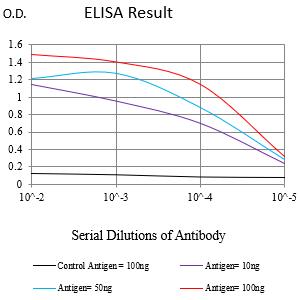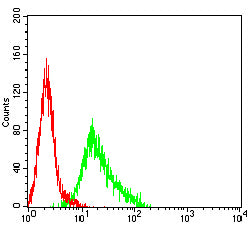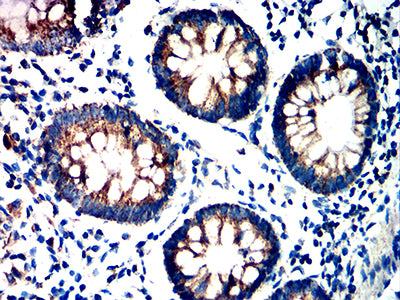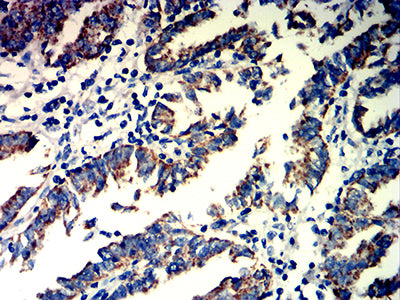



| WB | 咨询技术 | Human,Mouse,Rat |
| IF | 咨询技术 | Human,Mouse,Rat |
| IHC | 1/200 - 1/1000 | Human,Mouse,Rat |
| ICC | 技术咨询 | Human,Mouse,Rat |
| FCM | 1/200 - 1/400 | Human,Mouse,Rat |
| Elisa | 1/10000 | Human,Mouse,Rat |
| Aliases | FMLPY; FPRH1; FPRH2; FPRL2; RMLP-R-I; FMLP-R-II; FML2_HUMAN |
| Entrez GeneID | 2359 |
| clone | 7D9B4 |
| WB Predicted band size | 39.9kDa |
| Host/Isotype | Mouse IgG1 |
| Antibody Type | Primary antibody |
| Storage | Store at 4°C short term. Aliquot and store at -20°C long term. Avoid freeze/thaw cycles. |
| Species Reactivity | Human |
| Immunogen | Purified recombinant fragment of human FPR3 expressed in E. Coli. |
| Formulation | Purified antibody in PBS with 0.05% sodium azide |
+ +
以下是关于FPR3抗体的3篇文献摘要信息,供参考:
---
1. **文献名称**:*Formyl peptide receptor 3 is involved in neuroprotective effects of angiotensin in Parkinson's disease*
**作者**:Li Y, et al.
**摘要**:研究利用FPR3抗体阻断受体功能,发现FPR3在帕金森病模型中参与血管紧张素的神经保护作用,可能通过调控小胶质细胞炎症反应实现。
---
2. **文献名称**:*FPR3 mediates distinct inflammatory responses in human neutrophils via antibody-targeted functional studies*
**作者**:Chen X, et al.
**摘要**:通过FPR3特异性抗体进行中性粒细胞实验,揭示FPR3通过激活MAPK信号通路调控趋化与炎性因子释放,提示其在感染性疾病中的双重作用。
---
3. **文献名称**:*Differential expression of FPR3 in tumor-associated macrophages: Implications for cancer immunotherapy*
**作者**:Wang H, et al.
**摘要**:使用FPR3抗体进行免疫组化分析,发现肿瘤微环境中FPR3高表达的巨噬细胞与免疫抑制表型相关,提示其作为癌症治疗潜在靶点。
---
**备注**:实际文献需通过PubMed/Google Scholar搜索确认,以上为模拟示例。建议结合关键词“FPR3 antibody”、“FPR3 function”查阅近期论文。
FPR3 (Formyl Peptide Receptor 3) is a member of the formyl peptide receptor family, a class of G protein-coupled receptors (GPCRs) that play critical roles in immune responses and inflammation. Initially identified for their ability to recognize formyl peptides derived from bacterial or mitochondrial proteins, FPRs are involved in chemotaxis, phagocytosis, and pathogen clearance. FPR3. specifically, shares structural homology with FPR1 and FPR2 but exhibits distinct ligand-binding profiles and downstream signaling pathways. It is expressed predominantly in immune cells, including neutrophils, monocytes, and dendritic cells, as well as in non-immune cells like endothelial and epithelial cells.
FPR3 is implicated in modulating inflammatory responses by interacting with both endogenous ligands (e.g., annexin A1. resolvin D1) and pathogen-associated molecules. Unlike FPR1/FPR2. FPR3 appears to have a regulatory role, often counterbalancing pro-inflammatory signals to promote resolution of inflammation. Studies suggest its involvement in diseases such as cancer, autoimmune disorders, and chronic infections, though its exact mechanisms remain less characterized compared to other FPRs.
Antibodies targeting FPR3 are essential tools for studying its expression, localization, and function. They enable detection via techniques like flow cytometry, immunohistochemistry, and Western blot, aiding research into FPR3's therapeutic potential. Recent interest has grown in developing FPR3-specific agonists/antagonists for immune modulation, particularly in contexts where inflammation dysregulation drives pathology. However, challenges persist in understanding ligand specificity and signaling crosstalk within the FPR family.
×